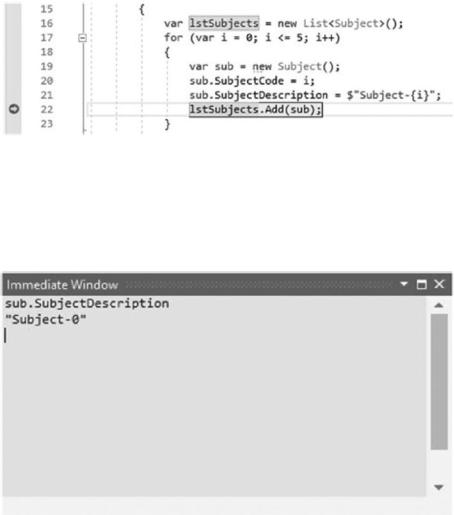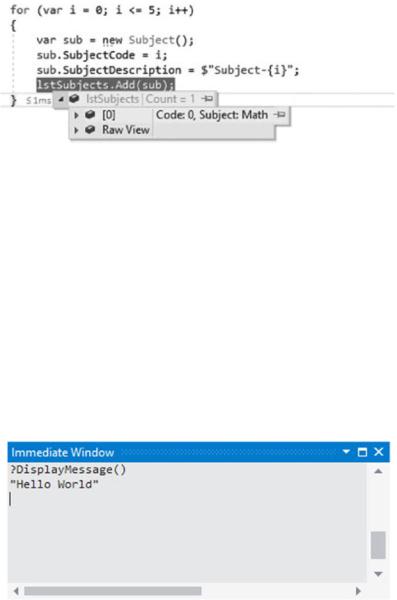
- •Table of Contents
- •About the Author
- •About the Technical Reviewer
- •Acknowledgments
- •Introduction
- •Installing Visual Studio
- •Visual Studio 2022 System Requirements
- •Operating Systems
- •Hardware
- •Supported Languages
- •Additional Notes
- •Visual Studio Is 64-Bit
- •Full .NET 6.0 Support
- •Using Workloads
- •The Solution Explorer
- •Toolbox
- •The Code Editor
- •New Razor Editor
- •What’s Available?
- •Hot Reload
- •Navigating Code
- •Navigate Forward and Backward Commands
- •Navigation Bar
- •Find All References
- •Find Files Faster
- •Reference Highlighting
- •Peek Definition
- •Subword Navigation
- •Features and Productivity Tips
- •Track Active Item in Solution Explorer
- •Hidden Editor Context Menu
- •Open in File Explorer
- •Finding Keyboard Shortcut Mappings
- •Clipboard History
- •Go To Window
- •Navigate to Last Edit Location
- •Multi-caret Editing
- •Sync Namespaces to Match Your Folder Structure
- •Paste JSON As Classes
- •Enable Code Cleanup on Save
- •Add Missing Using on Paste
- •Features in Visual Studio 2022
- •Visual Studio Search
- •Solution Filters
- •Visual Studio IntelliCode
- •Whole Line Completions
- •Visual Studio Live Share
- •Summary
- •Visual Studio Project Types
- •Various Project Templates
- •Console Applications
- •Windows Forms Application
- •Windows Service
- •Web Applications
- •Class Library
- •MAUI
- •Creating a MAUI Application
- •Pairing to Mac for iOS Development
- •Consuming REST Services in MAUI
- •The Complete Weather App
- •The Target Platforms
- •The Required NuGet Package
- •The Weather Models
- •The WeatherService
- •The MainViewModel
- •Registering Dependencies
- •Building the MainPage View
- •Using SQLite in a MAUI Application
- •The ToDoItem Model
- •The ToDoService
- •The MainViewModel
- •Registering Dependencies
- •Building the MainPage View
- •Managing NuGet Packages
- •Using NuGet in Visual Studio
- •Hosting Your Own NuGet Feeds
- •Managing nmp Packages
- •Creating Project Templates
- •Creating and Using Code Snippets
- •Creating Code Snippets
- •Using Bookmarks and Code Shortcuts
- •Bookmarks
- •Code Shortcuts
- •Adding Custom Tokens
- •The Server Explorer
- •Running SQL Queries
- •Visual Studio Windows
- •C# Interactive
- •Code Metrics Results
- •Maintainability Index
- •Cyclomatic Complexity
- •Class Coupling
- •Send Feedback
- •Personalizing Visual Studio
- •Adjust Line Spacing
- •Document Management Customizations
- •The Document Close Button
- •Modify the Dirty Indicator
- •Show Invisible Tabs in Italics in the Tab Drop-Down
- •Colorize Document Tabs
- •Tab Placement
- •Visual Studio Themes
- •Summary
- •Setting a Breakpoint
- •Step into Specific
- •Run to Click
- •Run to Cursor
- •Force Run to Cursor
- •Conditional Breakpoints and Actions
- •Temporary Breakpoints
- •Dependent Breakpoints
- •Dragging Breakpoints
- •Manage Breakpoints with Labels
- •Exporting Breakpoints
- •Using DataTips
- •Visualizing Complex Data Types
- •Bonus Tip
- •Using the Watch Window
- •The DebuggerDisplay Attribute
- •Evaluate Functions Without Side Effects
- •Format Specifiers
- •dynamic
- •hidden
- •results
- •Diagnostic Tools
- •CPU Usage
- •Memory Usage
- •The Events View
- •The Right Tool for the Right Project Type
- •Immediate Window
- •Attaching to a Running Process
- •Attach to a Remote Process
- •Remote Debugger Port Assignments
- •Remote Debugging
- •System Requirements
- •Download and Install Remote Tools
- •Running Remote Tools
- •Start Remote Debugging
- •Summary
- •Creating and Running Unit Tests
- •Create and Run a Test Playlist
- •Testing Timeouts
- •Using Live Unit Tests
- •Using IntelliTest to Generate Unit Tests
- •Focus IntelliTest Code Exploration
- •How to Measure Code Coverage in Visual Studio
- •Summary
- •Create a GitHub Account
- •Create and Clone a Repository
- •Create a Branch from Your Code
- •Creating and Handling Pull Requests
- •Multi-repo Support
- •Compare Branches
- •Check Out Commit
- •Line Staging
- •Summary
- •Index

Chapter 3 Debugging Your Code
Table 3-1. Performance Tools for Project Types
Performance Tool |
Windows Desktop |
UWP |
ASP.NET/ASP.NET Core |
|
|
|
|
CPU Usage |
Yes |
Yes |
Yes |
Memory Usage |
Yes |
Yes |
Yes |
GPU Usage |
Yes |
Yes |
No |
Application Timeline |
Yes (XAML) |
Yes |
No |
PerfTips |
Yes |
Yes |
Yes |
Performance |
No |
No |
No |
Explorer |
|
|
|
IntelliTrace |
.NET with VS Enterprise |
.NET with VS Enterprise |
.NET with VS Enterprise |
|
only |
only |
only |
Events viewer |
Yes |
Yes |
Yes |
.NET Async |
Yes (.NET only) |
Yes |
Yes |
.NET Counters |
Yes (.NET Core only) |
No |
Yes (ASP.NET Core only) |
Database |
Yes (.NET Core only) |
No |
Yes (ASP.NET Core only) |
.NET Object |
Yes (.NET only) |
Yes |
Yes |
Allocation |
|
|
|
|
|
|
|
Immediate Window
The Immediate Window in Visual Studio allows you to debug and evaluate expressions, execute statements, and print the values of variables. If you don’t see the Immediate Window, go to the Debug menu, and select Windows, and click Immediate or hold down Ctrl+D, Ctrl+I.
Let’s place a breakpoint in one of our for loops as seen in Figure 3-48.
202

Chapter 3 Debugging Your Code
Figure 3-48. Breakpoint hit
Opening up the Immediate Window and typing in sub.SubjectDescription will display its value as seen in Figure 3-49.
You can also use ? sub.SubjectDescription to view the value of the variable.
Figure 3-49. Immediate Window
If you had entered sub.SubjectDescription = "Math", you would be updating the value from “Subject-0” to “Math” as seen in Figure 3-50.
203

Chapter 3 Debugging Your Code
Figure 3-50. Variable value changed
You can also execute a function at design time (i.e., while not debugging) using the Immediate Window. Add the code in Listing 3-10 to your project.
Listing 3-10. DisplayMessage Function
static string DisplayMessage()
{
return "Hello World";
}
In the Immediate Window, type ?DisplayMessage() and press Enter. The Immediate Window will run the function and return the result as seen in Figure 3-51.
Figure 3-51. Execute the DisplayMessage function
Any breakpoints contained in the function will break the execution at the breakpoint. Use the debugger to examine the program state.
204
